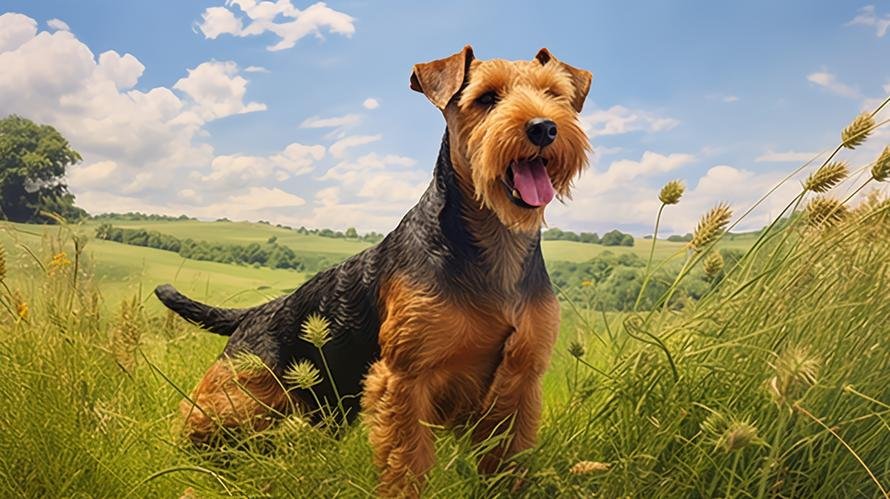Why are Welsh Terriers referred to as the “Airedales in disguise?” Because despite their resemblance to the Airedale breed, Welsh Terriers have their unique traits, one of which is their proclivity to shedding. If you’re familiar with the furry, small to medium-sized terriers out there, you know that the shedding habits of these dogs might be linked more to pet-friendly homes than grand sweeping meadows.
A rare breed, the Welsh Terrier’s predisposition for shedding is a popular topic within the potential dog owner community. However, the answers to this question are just as diverse as the breed itself. Let’s dive into the world of this robust and game breed to understand their shedding behaviors, shedding course of action, and more intriguing facts about these spirited terriers.
An interesting fact is that despite having a bushy coat, Welsh Terriers do not actually shed a lot. Unlike many other dog breeds that might turn your furniture and carpet into fur nests, the Welsh Terrier sheds comparatively less. Their lack of profuse shedding is one of the charming qualities that make them a favorite among pet owners, especially those who might have mild pet allergies or those who simply dislike regular vacuuming.
Let’s unpack this unusual phenomenon. Welsh Terriers have a double coat comprising a dense, soft undercoat that provides insulation and a wiry, hard outer coat that protects them from harsh weather and thorny brambles. However, unlike most dogs with a similar two-layered coat, the Welsh Terrier’s hair doesn’t loosen and fall out periodically. Instead, it gets stuck within the undercoat, resulting in a steady, minimal shedding cycle.
Just imagine your own hair growth and shedding process – similar to us humans, the hair on your Welsh Terrier will shed and regrow over time too. They lose old or damaged hair by shedding. Although shedding is a normal process for Welsh Terriers, the amount and frequency of hair that is shed often depends upon their health, breed type, and seasonal changes.
You might be thinking, “Why don’t Welsh Terriers shed a lot?”. The genetic trait of low shedding comes from their ancestral lineage. Originally bred for hunting in the valleys of Wales during the late 19th century, their coats were designed by nature to provide protection in all types of weather and terrain, which substantially reduced the amount of shedding, to maintain a dense, protective coverage.
Now, does this mean you can ditch that vacuum cleaner? Not exactly. Welsh Terriers still shed but to a limited degree. To add to that, their hair might get tangled and matted if not routinely combed, so there’s still some cleaning involved. Low-shedding doesn’t equate to zero grooming. In fact, Welsh Terriers require frequent brushing to remove loose hair and prevent matting.
‘Bonus Tip: Investing in a quality pet hair vacuum cleaner might be a good idea for a pet-friendly home even if you own a Welsh Terrier. It helps to pick up loose hair, dander, and allergens.’
Unlike dogs with short fur, Welsh Terriers need to visit a professional groomer every 6 to 8 weeks for a process known as “hand stripping”. This practice involves pulling out loose, dead hair from the roots to stimulate and maintain the quality and color of their coats. It is a meticulous and time-consuming process but is necessary to keep the dog’s coat in the best condition.
Another interesting fact is that Welsh Terriers are considered one of the most ‘hypoallergenic’ breeds; while no dog is 100% hypoallergenic, qualities such as low shedding and a particular type of coat make Welsh Terriers a better choice for those with mild animal-induced allergies.
But remember, every dog is unique and might not follow textbook traits. While Welsh Terriers are typically known for moderate shedding, factors like age, diet, overall health, and stress levels can impact this. Unexplained excessive shedding could be a sign of health problems such as nutritional deficiencies, hormonal imbalances, or skin infections. In such cases, it is essential to consult with a vet.
In conclusion, Welsh Terriers, with their lively and affectionate disposition, make delightful companions. Their coat, which sheds minimally, adds to their charm, making them suitable for individuals and families who might be concerned about excessive shedding. But this doesn’t mean you can forgo grooming and still expect a stylish and well-maintained terrier. Regular grooming, accompanied by a balanced diet and ample exercise, can ensure your Welsh Terrier stays healthy, happy, and looking sharp, just like the dapper Welsh gentleman they are!



